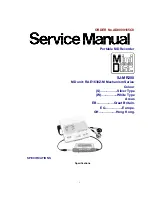
42
TASCAM DA-6400/DA-6400dp
7 – Internal Settings
Network functions (FTP server/telnet/
VNC)
FTP (file transfer protocol) server
By using an FTP client function, you can transfer files between
this unit and a computer. Connect to this unit and log in as you
would with another FTP server.
When you connect and log in, “ssd” and “usb0” will appear in the
root directory. These directories are SSD/HDD and USB.
If the corresponding media is not loaded, nothing will appear
beneath “ssd” and “usb0”.
NOTE
•
Data in files and folders with names that use Japanese or
other multibyte characters cannot be displayed or trans-
ferred properly. When using the FTP function, use only
half-width alphabetical letters, numbers and symbols (ASCII
characters) in file and folder names.
•
For information about FTP client applications that have
already been confirmed to work with this unit, please
contact TASCAM customer support (contact information at
the end of this manual).
8
Required settings for FTP connection
The following settings are necessary to connect to this unit by
FTP.
IP address: The IP address of the unit is shown in the IP
ADDRESS item on the
NETWORK
page.
Port number: 21
User name: DA-6400
Case-sensitive (cannot be changed)
Password: DA-6400 (default) (Case-sensitive)
This can be changed on the
PASSWORD
screen.
(See “Network function settings” on page 39.)
NOTE
•
FTP connection is not possible when the
EXTERNAL
CONTROL
item is set to
LOCK
on the
LOCK SETUP
screen.
•
If the setting is changed to
LOCK
when there is an FTP
connection, the connection will be interrupted.
•
If a
NETWORK
page setting is changed when there is an
FTP connection, the connection will be interrupted.
8
Overview of file operations using an FTP client
application
1. Reading files from the unit
Reading files from the unit is always possible.
2. Adding new files to the unit
Adding new files to the unit is always possible.
If BWF or WAV files are added to the current folder during
recording, files will be shown in the list in order from existing
files to recorded files and then added files.
3. Overwriting existing files on the unit
The current take can only be overwritten when the unit is
stopped.
Overwriting all other existing files on the unit is always
possible. However, if the
MODE
item on the
PLAY MODE
screen is set to
ALL
and the unit is playing, overwriting the
take after the current take might not be possible depending
on the timing. (See “Setting the play mode” on page 35.)
CAUTION
•
Problems might occur if the size, number of channels, bit
depth or sampling frequency of the overwritten file differs
from the original file.
The following error message will appear if playback is
attempted when the problem has occurred.
Delete that take from the SSD/HDD to resolve the problem
and stop the error message from appearing.
•
Do not overwrite existing audio files with files that use
different sampling frequencies. Doing so could make it
impossible to resolve the problem
4. Deleting files on the unit
The current take can only be deleted when the unit is
stopped.
Files other than the current take can be deleted at any time.
You must rebuild after deleting a file, however, because
discrepancies between management and audio files will
occur.
o
After deleting a file (and after playback/recording
stops), when the following rebuild confirmation
message appears, execute rebuilding.
o
If you do not rebuild, discrepancies between the
management and audio files will occur, and the
following message might appear.
















































